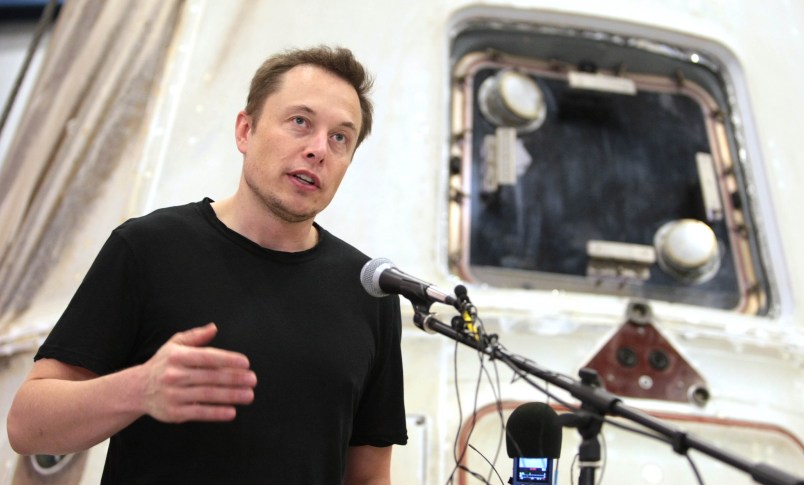CAPE CANAVERAL, Fla. (AP) — NASA is a giant step closer to launching Americans again from U.S. soil.
On Tuesday, the space agency picked Boeing and SpaceX to transport astronauts to the International Space Station in the next few years.
NASA Administrator Charles Bolden named the winners of the competition at Kennedy Space Center, next door to where the launches should occur in a few years. The wall behind him was emblazoned with the words “Launch America” and “Commercial crew transportation/The mission is in sight.”
“I want you to look behind me,” Bolden said, pointing both thumbs to the big, bright logos. “I’m giddy today, I will admit.”
The deal will end NASA’s expensive reliance on Russia to ferry astronauts to and from the space station. NASA has set a goal of 2017 for the first launch from Cape Canaveral, but stressed it will not sacrifice safety to meet that date.
NASA ended up going with a blend of old and new space: big traditional Boeing, which helped build the space station and prepped the space shuttles, and smaller, scrappier upstart SpaceX. Just 12 years old, the California-based SpaceX already is delivering supplies to the space station — its crew capsule is a version of its cargo carrier.
NASA will pay Boeing $4.2 billion and SpaceX $2.6 billion to certify, test and fly their crew capsules. The two contracts call for at least two and as many as six missions for a crew of four as well as supplies and scientific experiments, said NASA’s Kathy Lueders, commercial crew program manager. The spacecraft will double as emergency lifeboats at the orbiting outpost.
SpaceX billionaire founder and chief executive, Elon Musk, was elated by Tuesday’s news, as were Boeing’s top managers.
“Deeply honored and appreciative of the trust that NASA has placed in SpaceX for the future of human spaceflight,” Musk said in a tweet.
Noted Boeing’s John Elbon, vice president and general manager of space exploration: “Boeing has been part of every American human space flight program, and we’re honored that NASA has chosen us to continue that legacy.”
The third major contender, Sierra Nevada Corp., had the most novel entry, a mini-shuttle named Dream Chaser that it was developing in Colorado.
NASA officials declined to elaborate on the decision and why Sierra Nevada lost out. In a statement, Sierra Nevada said it would wait to hear NASA’s rationale before commenting further on the options for its spacecraft. While disappointed that it wasn’t selected, the company said it “commends NASA for initiating the effort.”
U.S. astronauts have been riding Russian rockets ever since NASA’s space shuttles retired in 2011. The latest price tag is $71 million per seat; NASA puts at least four of its astronauts on a Russian Soyuz every year. SpaceX has indicated its seats will cost $20 million apiece.
“From day one, the Obama administration has made it very clear that the greatest nation on Earth should not be dependent on any other nation to get into space,” Bolden told reporters.
The commercial crew program follows the successful cargo delivery effort underway for the past two years, also under NASA contract. The objective, for years, has been for NASA to hand space station flights to private companies and focus on getting astronauts into true outer space, with destinations such as asteroids and Mars. NASA is prepping its first-ever Orion deep-space exploration capsule for an unmanned test flight in December.
Musk’s Space Exploration Technologies Corp. — SpaceX for short — became the first private company to launch a spacecraft into orbit and retrieve it in 2010. The SpaceX Dragon capsule made its first space station trip, with astronaut supplies, in 2012.
The Dragon cargo carrier has been enhanced to carry as many as seven astronauts. It’s known as Dragon v2 — version two.
Orbital Sciences Corp. of Virginia, which also makes unmanned space station shipments, did not vie for crew-carrying privileges.
Boeing’s entry was also a capsule, called CST-100. The letters stand for Crew Space Transportation, and the number refers to 100 kilometers or 62 miles, the official start of space. Boeing will use a former shuttle hangar at Kennedy to build the capsules.
Sen. Bill Nelson, D-Fla., said Boeing alone will add 550 jobs to Cape Canaveral, welcome news for a region still struggling economically from the shuttle shutdown.
Both spacecraft will meet rigorous safety standards for the astronauts who will fly on them, officials stressed. CST-100 will fly atop an Atlas V rocket, while SpaceX will use its own Falcon 9 rocket. NASA astronaut Mike Fincke noted that while the capsules may be small, they’re carrying “big expectations.”
NASA paid each of these three major contenders hundreds of millions of dollars in recent years to spur development.
The differing amounts of these two new contracts were based on each company’s proposal, Lueders said.
Amazon.com founder Jeff Bezos’ Blue Origin company in Washington state received NASA funding in the early rounds of competition, then said it would continue working on its own, unfunded by the government. The company had given sparse details about its progress and intent.
Rocket maker United Launch Alliance, which is behind the Atlas V, scheduled a news conference on Wednesday with Bezos to discuss a possible collaboration. The company has been under pressure, given the political tension between the two countries, to come up with a backup for the Russian-built main engine in the Atlas V.
___
Online:
NASA: http://www.nasa.gov/exploration/commercial/crew/
SpaceX: http://www.spacex.com/
Sierra Nevada: http://tinyurl.com/mqv9md9
Boeing: http://tinyurl.com/qjx5p9u
Blue Origin: http://www.blueorigin.com/
Copyright 2014 The Associated Press. All rights reserved. This material may not be published, broadcast, rewritten or redistributed.






